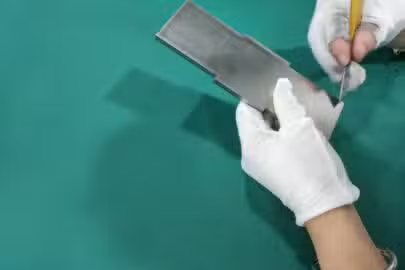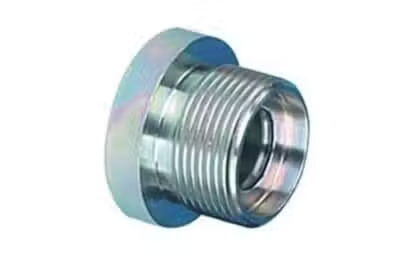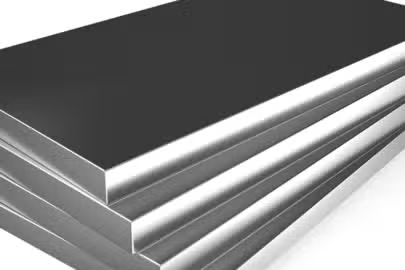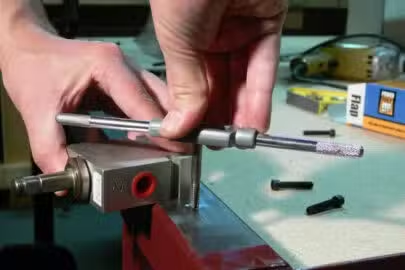Surface finish plays a pivotal role in determining a wide range of products aesthetic appeal, functionality, and overall quality. Polishing is a meticulous and transformative process among the different methods employed to enhance surface characteristics. Polishing surface finish is not merely about creating a visually pleasing exterior but involves a sophisticated interplay of techniques and materials to achieve optimal smoothness, cleanliness, and durability.
Polishing is the process of reducing the surface roughness of a workpiece using mechanical, chemical, or electrochemical effects to achieve a bright and smooth surface. It modifies the surface of metal parts with abrasive grains and polishing tools or other polishing media.
In this guide, we explore the world of surface finishing, uncovering the significance of polishing, the techniques involved, and the diverse applications across industries. The journey of polishing surface finish reveals a fascinating fusion of craftsmanship and science, whether to elevate the elegance of consumer goods or improve the performance of critical components.
What Is Polish Surface Finishing?
Polish surface finishing, also known simply as polishing, is a meticulous process aimed at refining and enhancing the surface characteristics of materials. It is a crucial step in manufacturing and craftsmanship. It contributes to the visual appeal and the functionality and longevity of a diverse array of products. Polishing involves the removal of imperfections and irregularities from a material’s surface, resulting in a smoother and more reflective finish. This transformative technique is applied across various industries, from automotive and aerospace to jewelry and consumer goods.
One of the most apparent outcomes of polishing is the enhancement of a material’s aesthetics. A polished surface exhibits a reflective quality that adds elegance and sophistication, making it particularly desirable for jewelry, metal fixtures, and high-end consumer goods. Beyond the visual allure, polishing serves a functional purpose. Smoothing out surface irregularities reduces friction, wear, and corrosion. This can be essential in industries where the performance and longevity of components are paramount, such as in CNC machining, engine parts, and medical devices.
Polishing not only imparts a polished sheen but also facilitates easier cleaning. Smooth surfaces are less prone to accumulating dirt and contaminants, making them more hygienic and easier to maintain. This is particularly important in medical equipment, food processing, and pharmaceutical manufacturing applications. The polish surface finish process involves abrasive materials, polishing compounds, and skilled craftsmanship. Different materials, like metals, plastics, and ceramics, may require specific techniques and tools tailored to their unique properties.
Steps Involved in Polishing Surface Finish
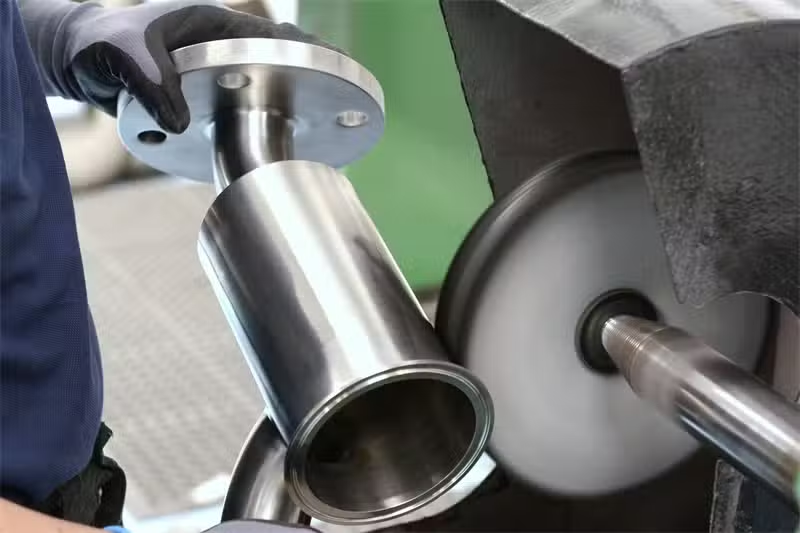
These are the steps involved in the polishing surface finish process:
Roughing
This step removes scratches and abrasions caused by metal cutting and welding. It can be applied to the entire surface or a specific component segment. A random orbit sander, sandpaper, a burnishing polishing machine, and angle grinders are some tools used in roughing.
The random orbit sander is ideal for large surfaces and can work with metals such as steel and aluminum. The burnishing polishing machine presses through the surface, smoothing out any rough spots and leaving a shiny finish.
Angle grinders are excellent for smoothing out scratches and nicks at awkward angles. An abrasive tool’s diameter and number of grits determine whether it is best suited for an entire metal part or a small surface.
Polishing
Once the roughing step is complete, a quick-cut abrasive paste can brush up the affected area or the entire part surface. As a result, the polishing surface finish process employs wool berets and polishing sponges to help spread the abrasive paste. The sponges and berets have varying degrees of hardness. As a result, we can achieve a different polished surface grade for prototypes and custom parts. Following the polishing process, a microfiber cloth can aid in effectively cleaning the surface.
Brightening
This is also known as buffing. It enhances the brightness of polished surfaces such as cutlery using specialized equipment with soft and delicate surfaces. An airflow mop may be used during the light buffing process to ensure consistency of surface brightness.
Protecting
Most metal surfaces deteriorate when exposed to oxygen, water, or high temperatures, causing the surface to rust and lose its luster. This fourth and final step entails applying a protective coat primarily of wax or grease, depending on the component. Coating this ultimately aims to increase the component’s working life.
Types of Polishing Surface Finish
There are three main types of the polishing surface finish, and they are:
Electrolytic Polishing
Electrolytic polishing is also known as electrochemical polishing or anode polishing. The main principle of electrolytic polishing is similar to chemical polishing in that the dissolving liquid dissolves small protrusions on the surface to produce a smooth surface. However, when compared to chemical polishing, the cathode reaction is eliminated, and the polishing effect is improved. Electrolytic polishing removes material from metal workpieces, reducing surface roughness and improving surface finish by leveling micro peaks and valleys.
Mechanical Polishing
Mechanical polishing is a technique that relies on cutting and plastic deformation of the material’s surface to achieve a smooth surface by removing polished protrusions. Mechanical polishing is mostly done by hand with grinding rods, felt wheels, and sandpaper. Auxiliary tools such as turntables can be used for particular parts such as rotating bodies, and precision polishing can be used for high surface quality needs. In ultra-precision polishing, a unique polishing abrasive tool rotates at high speed on the surface of the workpiece in an abrasive-containing polishing liquid. This technology, the best among various polishing methods, can achieve a surface roughness of 0.008m.
Chemical Polishing
A smooth surface is produced during chemical polishing because the micro-protruding portion of the material surface dissolves more easily in the chemical medium than the concave portion. A passivation layer forms on the metal surface as a result of the solution’s and the galvanic couple’s influence during the chemical polishing process. Chemical polishing directly leads to the smoothing of micro-roughness and the concurrent dissolution of the upper layer.
The process can polish several metal components at once as well as intricately shaped workpieces. After chemical polishing, the surface roughness is roughly Ra10m.
What Metals Can Take Polishing Finish?
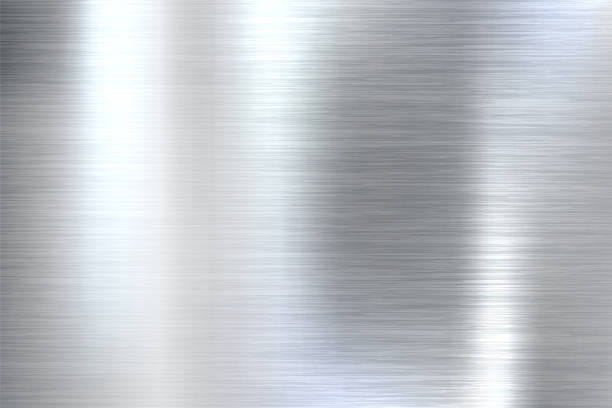
Polishing is a versatile surface finishing technique applied to various metals. Different metals may require specific polishing methods and tools, but in general, the following metals are commonly subjected to polishing:
- Stainless Steel: This is a common choice for polishing due to its corrosion resistance and aesthetic appeal. Polishing stainless steel can enhance its shine, remove surface imperfections, and contribute to a clean, polished finish.
- Aluminum: This is a lightweight metal commonly used in various industries. Polishing aluminum improves its appearance and helps protect it from oxidation. This is particularly important in applications with a desired polished, corrosion-resistant surface.
- Brass: This is an a mix of copper and zinc. It is known for its gold-like appearance. Polishing brass enhances its luster and maintains its decorative qualities. It is often used to produce musical instruments, jewelry, and decorative items.
- Copper: Like brass, copper is a metal with inherent aesthetic appeal. Polishing copper surfaces brings out its reddish-brown luster, making it a perfect choice for decorative elements and artistic applications.
- Titanium: Titanium, known for its strength and lightweight, can be polished to achieve a sleek, metallic finish. Polished titanium is commonly used in the aerospace industry, medical devices, and high-end sports equipment.
- Bronze: This is an alloy of tin and copper. It is prized for its historical significance and artistic appeal. Polishing bronze surfaces highlights its warm, reddish-brown tones and is often used in sculptures, artwork, and architectural elements.
Can Plastics Be Polished?
You can polish plastic parts to improve their appearance and smooth out surface imperfections. However, plastic polishing techniques and compounds may differ from those used for metals.
The suitability of a plastic part for polishing is determined by several factors, including the type of plastic, its hardness, and its heat resistance. Acrylic (PMMA), polypropylene (PP), ABS (Acrylonitrile Butadiene Styrene), and polycarbonate (PC) are some common plastics that can be polished.
Pros and Cons of Polishing Surface Finish

Here are some of the pros and cons of the polishing surface finish:
Pros
- Enhanced Aesthetics: Polishing creates a reflective surface, imparting a mirror-like shine to materials such as metals and plastics. This enhances the visual appeal of products, making them more attractive to consumers.
- Improved Cleanliness and Hygiene: Polishing removes surface imperfections, creating a smooth finish. Smooth surfaces are quite easy to clean and are less prone to accumulating dirt, grime, and contaminants. This is particularly important in applications where hygiene is crucial, such as medical equipment and food processing.
- Increased Corrosion Resistance: Polishing helps eliminate micro-scale imperfections and irregularities contributing to corrosion. A polished surface acts as a protective barrier, enhancing the corrosion resistance of materials like stainless steel and aluminum.
- Reduced Friction and Wear: Polishing reduces surface roughness, minimizing friction and wear between moving parts. This is essential in applications that require smooth operation and minimal wear, such as precision machinery and automotive components.
- Reduced Material Waste: In some cases, polishing can be sustainable as it reduces the need for additional coatings or finishes. This can contribute to reducing material waste and the environmental impact of manufacturing processes.
Cons
- Time-Consuming: Achieving a high-quality polished surface often requires time-consuming and labor-intensive processes, especially when dealing with intricate or complex shapes. This can increase production costs.
- Costs: The required machinery, abrasive materials, and polishing compounds can contribute to initial setup costs. Additionally, the ongoing consumption of abrasives may lead to recurring expenses.
- Skilled Labor Required: Achieving consistent and high-quality polishing results often requires skilled craftsmanship. Training and retaining qualified personnel can be a challenge for some industries.
- Complex Geometries: Challenges with Complex Shapes: Polishing intricate or complex shapes can be challenging, as accessing certain areas with traditional polishing tools may be difficult. Specialized equipment and techniques may be required.
Applications of Polishing Surface Finish
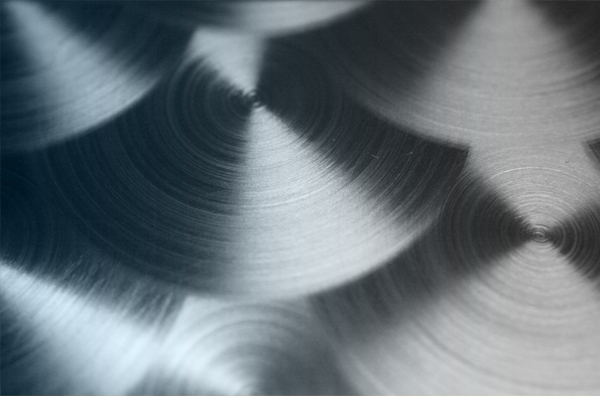
There are several applications of polished surface finish for your rapid prototyping products and other needs:
Medical Applications
Polishing is essential in medical applications for surgical instruments to ensure smooth surfaces, reducing the risk of tissue damage and facilitating sterilization. It’s also crucial for dental equipment, medical implants, and various medical devices, contributing to patient safety and device longevity.
Aerospace Applications
In aerospace, polished surfaces are vital for aircraft parts such as engine parts, turbine blades, and interiors. Polishing reduces friction, improves aerodynamics, and enhances fuel efficiency. It’s also applied to satellite components and spacecraft for solar reflectors, optimizing energy absorption in space.
Electrical Applications
Polishing is critical for connectors and contacts in electrical applications to minimize surface resistance, ensuring reliable electrical conductivity. It’s also employed in semiconductor manufacturing for wafer planarization, enhancing the flatness and uniformity of surfaces in microelectronics production.
Marine Applications
To enhance corrosion resistance in saltwater environments, polishing is applied to ship components like propellers and navigational instruments. It ensures critical components remain aesthetically pleasing and functional in harsh marine conditions.
Construction Applications
Polishing is significant in construction applications for architectural metalwork, stainless steel fabrications, and glass surfaces. It enhances the aesthetic appeal of architectural elements, provides corrosion resistance to stainless steel, and improves the transparency of glass surfaces in buildings.
Practical Tips for Polishing Surface Finishing
There are practical surface polishing tips to ensure you get the desired look. Some of these tips include:
Select the Right Polishing Tools
To avoid overheating the metal surface, use fast-cutting pastes, and don’t rub a spot too long. Abrasive discs with polyester films should be used for roughing to achieve uniform roughness levels. Similarly, use a dependable wax polish to protect a previously polished metal surface and ensure that your abrasive material is neither too liquid nor too hard.
Apply the Polishing Compounds Correctly
When polishing components with irregular shapes and sizes, it is ideal to vary the polishing direction constantly to ensure uniformity. Therefore, do not polish metal parts in a single direction. Furthermore, on metal surfaces, polish should be applied across rather than along marks and scratches.
Take Needed Safety Precautions
Every polishing procedure should be done while wearing the proper safety equipment because doing so could be hazardous if you are not covered. Using a dry, soft microfiber cloth removes grease or other stains from the metal components.
Choose Zintilon Excellent Finishing Solutions
Ensuring the finished goods satisfy quality requirements is the ultimate goal of any low-volume production or prototyping procedure. To guarantee that the products meet the necessary standards, surface finishing is one of the most essential post-production processes. At Zintilon, we recognize this and are prepared to make your dream of prototyping a reality.
In addition to having the most excellent technicians and manufacturing methods, Zintilon offers best-in-class finishes, such as a polished surface finish. To assist you in selecting the best option for your machined part, we collaborate with you. The best news is that we offer competitive pricing for all our services. Get a quote by uploading your design file now.
Conclusion
Polishing is essential to achieving a consistent, protective, and functional surface finish. Aside from the visible aesthetic appeal, polishing is also cost-effective and multipurpose. As it covers more materials and develops newer methods, the potential of this method to produce multiple types of surface finishing grows. The polishing process is known for its quasi-reflective surface, uniformly smooth texture, consistent color dispersal, and corrosion resistance.
